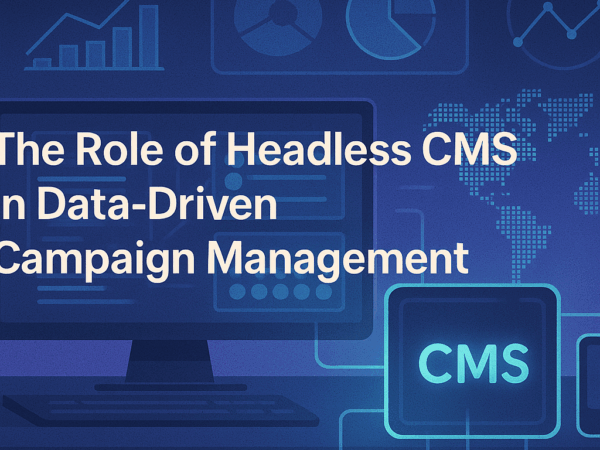The Role of Headless CMS in Data-Driven Campaign Management
Data is the driving force behind modern marketing. Every click, every impression, every conversion teaches a brand something new and allows them to better their approach for more relevant experiences. But leveraging data approaches for campaigns requires more than just analytics. It requires agility, speed and cross-platform cohesion. That’s why the Headless CMS is the solution. Allowing for decoupled content and presentation for better integration and utilization with all applicable data systems, a Headless CMS allows marketers to champion, adjust and scale data driven campaigns on the fly with a centralized approach to content creation and distribution. A headless CMS turns data into a narrative that creates other narratives for smarter, faster and more personalized approaches to marketing and campaign management.

The Campaign That Data Drives
Data-driven campaign management means that every facet of a marketing initiative from content creation to distribution and beyond is influenced by analytics and insights. No longer do marketing teams need to rely solely on best guesses and instincts, they can track customer usage, engagement, conversions, and compile a wealth of metrics that allow them to formulate precise, measurable campaigns.
The only problem? Execution. Axios all can be leveraged to handle multiple API requests simultaneously, streamlining how a Headless CMS pulls and distributes data across channels. Many CMS platforms are outdated in the age of data-driven campaigns, requiring updates, integrations, and the time it takes to scale content across multiple initiatives makes so much sense on paper but can quickly descend into chaos. But a Headless CMS can help, as it serves as a central hub with cross-channel application that allows data to inform where content needs to live most efficiently.
The Headless CMS Revolution for Modern Marketing
A Headless CMS is a content management system with a different decoupled framework. This means that content is treated as separate from where it needs to live. A Headless CMS allows users to create and edit content freely and APIs deliver that content where it needs to go be it website, mobile app, email or even digital signage.
For data-driven marketing efforts, this is important because Headless CMS platforms can directly integrate with where the CMS exists and other data-driven sources. As analytics determine what should be where and for whom based on performance insights, personalizations are easy to make in a decoupled realm. Therefore, time saved in receiving immediate feedback and seeing it help performance in real time makes modern marketing for the data-driven team easier to manage without having to stop production.
Taking Analytics Into Your Own Hands
Analytics shouldn’t be separate in a data-driven world. The seamless integration of a Headless CMS provides newfound access to platforms like Google Analytics, the Adobe Experience Cloud or even custom BI solutions. They all can lend insight in real-time as part of the content workstream instead of having to revisit sources at different times for success.
When successful campaigns are running, having access to the same metrics as those grading performance dashboards means quick changes can be made without additional approval or unnecessary documentation. If a headline isn’t working, swap it out. If analytics show users spending more time on subheadings in a blog post, create more opportunities to include entry points within the narrative. Providing analytics directly helps teams iterate with immediacy for continued impact.
Data-Driven Marketing is Built on Structured Content
Structured content is a data-driven marketer’s best friend. By housing content in blocks structured, modular, and reusable everything from product descriptions to headlines and calls-to-action is carefully separated in a Headless CMS for tagging, tracking, and optimization.
As a result, it’s easier for the data-driven marketer to track success by looking at performance instead of volume. What’s the most successful CTA across all channels? What product description is engaging people the most? When data plays with uniquely separated pieces of content to create a cohesive campaign, there are scientifically measurable elements that contribute to a comprehensive campaign instead of only collaborative content decisions.
The Speed of Automation and API Connectivity for Dynamic Data
A significant appeal of Headless CMS systems lies within the API-first approach that offers connectivity to dynamic data. It would connect with other software operating on similar APIs, meaning any campaign or content decision implemented can automatically change based on integrations or analytics without redeployment.
For example, if a multi-channel campaign isn’t optimized, a marketer can push changes through without refreshing or republishing across channels. The nature of automation and API connectivity facilitates speed and development for campaigns to ensure they’re always timely and working. Static content runs the risk of redundancy; with a Headless CMS engine powered by automation, users never need to worry about wasting time on unpublished updates.
Applying Data to Personalization
The personalization often critical to marketing comes through a Headless CMS’ capacity to integrate with CRMs, warehouses, and AI engines. When data is facilitated seamlessly, there’s potential for personalized campaigns based on previous purchases, browsing or buying history, and real-time suggestions.
For example, if a customer purchases a product and returns to the website, they may receive suggestions on complementary products. If a first-time visitor explores a webpage without logging in, they may still get educational tips about less popular products. The more integrated this process comes, the more practical it is for marketers to engage audiences they can use data without annoying users through unnecessary prompts that don’t appreciate past interactions.
Improved Marketing and Data Team Collaboration
Data-driven marketing aligns the creative team and data scientists for required collaboration. A Headless CMS supports this joint effort, allowing marketers to create and publish and data scientists to analyze, segment, and evaluate performance in an integrated platform where people from either team can access what they need and collaborate in real time.
This eliminated the siloed approach typical of separated creative and analytical operations. For example, if a campaign needs to be tweaked from the creative side based on performance metrics, this no longer necessitates a complicated handoff from one team to another. Instead, campaign changes are directed by common factors and made in real-time. The gap between creator and analyst is bridged with the Headless approach, fostering quicker operations on all ends.
Easier A/B Testing and Experimentation
Testing is a core tenet of any data-driven approach. Data-driven marketers want to continuously assess what’s working for their audiences. With a Headless CMS, A/B testing is simplified because multiple variations can be tested as structured content allows for easy swaps of headlines, images, CTAs, and more and tracked simultaneously.
Since front-end changes occur via APIs, Headless marketers can apply changes that work seamlessly across all channels in real-time instead of continually going back to something to re-update it for every instance. Instead of dedicated projects to determine which version is best, a Headless CMS creates a constant testing loop that allows findings to funnel directly into execution. This can occur much quicker when testing doesn’t become a time-consuming effort but instead something regularly turned over. Marketers will feel far more comfortable determining what’s best when they can do so in less time.
Centralized Data Management
Managing campaign content across too many channels creates content silos for one, the content isn’t brought together. In addition, all data is in one platform, performance insights are in another, and the reports tracking performance are stored elsewhere. A Headless CMS brings all operations under one roof for content creation, data gathering, and performance evaluation.
This streamlines efforts and provides better visibility. For example, by having one dashboard where marketers can find everything necessary for execution and reporting, silos are limited if not eliminated entirely. Thus, campaigns can all use a centralized system from the same structured data advantages. This increases consistency but also accuracy in how the separate parts are measured.
Operation of Automated Scaling
The key to a properly scaled data-driven campaign is automation. Where a Headless CMS connects to other automation features, it can facilitate proper connections through APIs that set up commands for system actions. For example, if the CMS does not receive a certain engagement number by a certain timeframe, it triggers another action that either changes the content or removes it.
Why take the time to add, adjust, and engage with campaigns when they can run on auto-pilot? Data-driven marketing requires engagement, but what if that engagement could be minimized through strategic automation? The ease of automation allows for consistent decisions to be made without manual intervention once pre-defined actions trigger specific CMS actions.
Cross Campaign Measurement Challenge
In data-driven campaigns, often one of the biggest challenges is understanding how the campaign impacts other touchpoints. A Headless CMS solves this issue by operating from one source of information that subsequently flows through all other engagement systems. Therefore, web, email, mobile and social touch points are all connected through similar inputs.
Thus, with integrated reporting, analytics found in one program can be housed in another. It’s never two worlds apart. By keeping everything connected in the same location, campaigns can be measured with a singular goal and accessed to provide unified reports about how audiences engage with similar content over time and across the customer journey.
Data should be used when it’s available and not just after a campaign has ended to determine if efficacy at various touchpoints is worth time and energy investment.
Balancing Speed & Consistency
When working in a data-driven environment, campaigns must move quickly to take advantage of opportunities; however, that should never sacrifice brand integrity. A Headless CMS creates a proper balance while allowing for campaign design through testing that’s still guided by pre-made templates.
For example, every chance to iterate created by on-going tests still relies on actionable items that come directly from brand-controlled resources. Therefore, templates bridge the gap between brand loyalty and time-sensitive action to ensure that no matter how fast a campaign is deployed or adjusted it’s always within the confines of brand messaging and expectations.
With a Headless CMS, brands can feel confident in their ability to maintain quick turnarounds without losing their brand voice or ultimate purpose. All iterations are considered pre-approved in concept.
Making Data-Execution Easy
One of the best things about a Headless CMS is that it connects the gap between strategy and execution. When data reveals insights into performance or audience behaviors, it only matters if teams can respond quickly and that’s what Headless facilitates. Content editors can swap out images or update a message if needed; there’s no need to wait for the next round of development plans.
Instead, if there’s a need for immediate feedback, it can come easy. The most important elements of campaign creation and execution exist from within the same platform. The need for creation isn’t even detached, it comes from the same analytics tab and operational side of things to make it as easy as possible.
Thus, it renders marketing the operational underpinning. Should big data prove something worthwhile, data-driven marketing champions can justify their practices and make the changes they believe will improve current operations.
Future Proofing Data-Driven Marketing Operations
The technology of the present and future is constantly evolving for better or worse. As long as user expectations shift along with opportunities for AI, automation, omnichannel data collection, and personalized experiences, there’s always a new frontier for campaigns to traverse.
A Headless CMS is naturally future-proof. Everything is integrated through an API-first connection that allows brands to easily connect other technology as they see fit; whether this is in response to engagement numbers, time on page, or other velocity data patterns that suggest real-time upgrades; it’s nice to know without a headache that building out will not be necessary.
Furthermore, as long as sound data-driven marketing principles are in place and they will be with personalized engines, voice-enabled assistance, or whatever else the users demand, brands can easily extend their CMS as needed down the road.
Conclusion: Headless CMS as the Engine of Smart Marketing
The future of marketing is for those who meld creative vision and data-driven actionable insight. A Headless CMS democratizes all content creation and distribution into a customizable, data-responsive platform that changes on a dime. It connects the dots between insight and action to create personalized, quantifiable campaigns across the board.
In a world of analytics, speed, and automation, the Headless CMS is the backbone of a new era of campaign implementation. It does not merely facilitate content; it supports performance, champions creativity, and turns data into actionable customer-centric experiences that enhance lifetime value.














